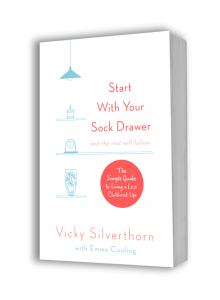The following post is taken from my book, Start With Your Sock Drawer: The Simple Guide to Living a Less Cluttered Life. You can buy a copy for yourself at Amazon.
Letting Go

It’s a great privilege to be invited into someone’s home. Over the years I have heard so many explanations, often very personal, as to why our homes can become overcrowded with belongings that we no longer want or need – and for every reason we have for hanging on to these objects, I have a method to help you move them on and free up your space, helping you to let go.
SENTIMENTAL ATTACHMENTS
The problem: I inherited it!
The chair’s not really my style and I haven’t got anywhere to put it, but I can’t get rid of it because my aunt left it to me in her will – it’s sentimental.
So many times a client will explain the presence of a random piece of furniture or ornament in their home by detailing how it was handed down to them, given by or inherited from a much-loved relative. We often feel obliged to hold onto such pieces, including clothes and knick-knacks, and believe that we could not bear to be parted from them. We can find ourselves filling cupboards, boxes and lofts with a whole host of possessions that won’t see the light of day because they do not suit our tastes – and yet we feel that we must hang on to them. Don’t get me wrong, I’m not suggesting that we have a ruthless cull of everything that we have inherited. Many of us have a few treasured items, often photos or jewellery that we love having on display or wearing; they bring us happy memories, suit our style and are a positive presence in our lives. These belongings are not the problem – what I’m talking about is the cupboard-hogging, space-stealing ‘stuff’ that is crowding corners and dragging us down.
Simple steps to a solution
When I lost my mum three years ago, I knew that going through her possessions would be a hard task, but for me it was something better faced sooner rather than later. I knew that the longer I left it, the harder I would find it to part with her possessions. To break down the task of dealing with this mountain of belongings, I mentally put each item into one of three categories:
- Objects that I genuinely loved and would treasure.
- Items I would feel guilty about parting with but didn’t feel a huge attachment to.
- Belongings that I felt little attachment to and could easily part with.
It would have been easy just to hang on to those items in the middle category, but deep down I knew this wasn’t the solution. So, instead, I asked myself a series of questions and acted immediately on my responses. Try doing the same with any inherited belongings you are unsure of, being mindful to focus fond thoughts and memories on those items you truly love rather than automatically attaching sentimentality to every item. Pop Post-It notes on everything you are planning on keeping. This will help you to visualise how much you need to find space for. If the room becomes a sea of little yellow squares then you need to re-think some choices!